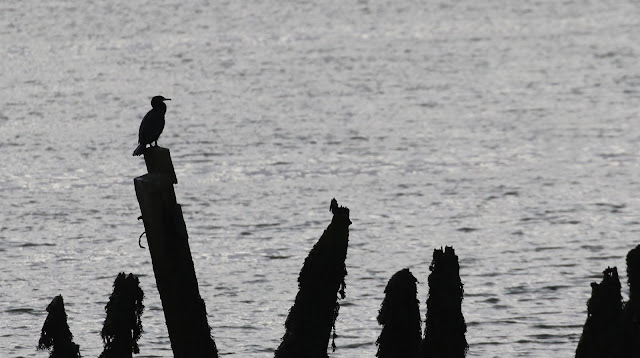Where we were staying, in Aldeburgh, had views out over the Aldeburgh marshes along with the Alde estuary.
The field in the evening has Hare, with a maximum of four being seen and just after sunrise a fox makes the trip across towards the river. I decided to go out for a walk in the afternoon, heading out across the marshes and heading inland towards the various pools that are present. I had to walk down to the river first, then take the path a short distance before heading inland.
This took me through a field covered in thistles where there was a large flock, probably close to one hundred birds, of Goldfinch feeding on the seed heads.
Last August we had walked across the field towards the river, today I was heading in the opposite direction, the took a path that headed through the centre of the marsh. This led to a reed lined path with several viewing points across pools of open water. I could see Teal dabbling around the edge and a few Ringed Plover. At the next open area in the reeds I was able to find two Ruff, a male, the larger bird and a female, there is also a redshank on the right
Better views of the large male.
here you can see the marked size difference in the male and female, the male at the back
Unfortunately there was no sign of the reported Little Stint. I followed the path to the raised bank that leads around the river estuary and decided to follow this back to the house. Scanning the field I found a large group of Black-tailed Godwits feeding on the marsh.
There were also Curlew, and Canada and Greylag Geese.
The open water I had been viewing from behind the reeds was visible, a little way off but easier to scan with the scope. As I moved around the edge of the water I found four Ringed Plover and with the last one a smaller wader, the Little Stint. This has to be one of the worst digiscoped record shots
The clouds were thinning out allowing the sun to break through and provide some watery sunshine and colour as it began to drop in the sky.
The calls of Curlew signaled a fly past.
More views across the marsh.
The tide had been high but was now dropping with the mud showing on the outside bends of the estuary meanders. The curlew were making their way from the marsh out on to the open mud.
A Little Egret dabbled its foot in the shallow water.
It was strange to find this Black-tailed Godwit at roost on the mud, it would have been expected to be feeding now.
Others were definitely feeding.
A Herring Gull stood in the reflection of the setting sunshine.
More Black-tailed Godwits flew in to join the feeding group.
Godwits silhouetted by the golden light on the mud.
Another view across the river with a mackerel sky developing. A mackerel sky is the common term for rows of cirrocumulus or altocumulus clouds displaying
an undulating, rippling pattern similar in appearance to fish scales, this
is caused by high altitude atmospheric waves. Cirrocumulus appears almost exclusively
with cirrus some way ahead of a warm front and is a
reliable forecaster that the weather is about to change
Looking away to the south.
A Cormorant sits on one of the old pier poles.
Turning in land I was able to find one of the Brown Hares that could be seen in the field beyond the house.
Walking up the path to the house I came across a party of Long-tailed Tits.
A little later I popped back out as the sun was setting to capture what was an incredibly colourful sunset with the sky and river being transformed by the light from the setting sun.
The light from the sinking sun was refracted by the gap in the clouds and intensified as the sun slipped behind the horizon.
You never know when to leave, I did too early and had to look back to capture the final intensity of the sun.
A beautiful place, made special by the time of year and aspect of the sun. The marshes are clearly a good spot for birds, but viewing is very difficult

































No comments:
Post a Comment